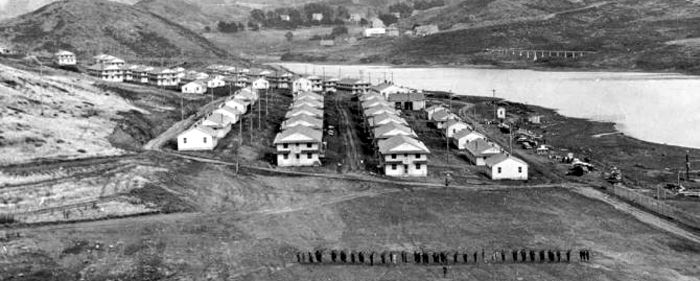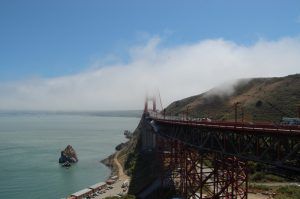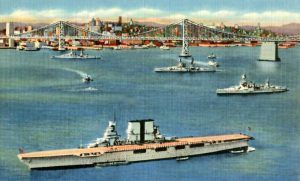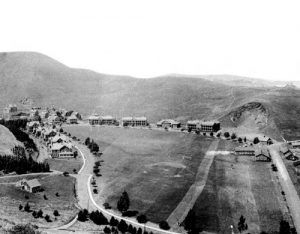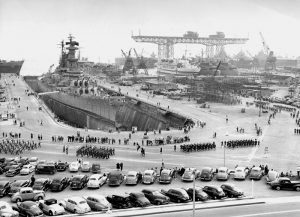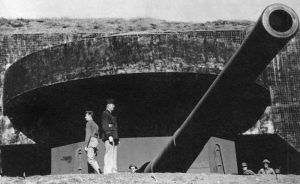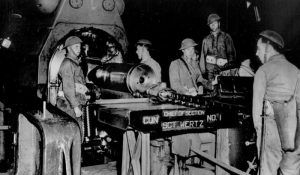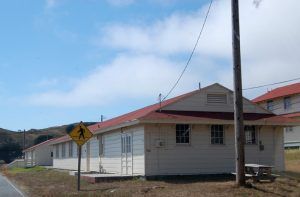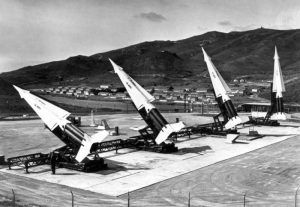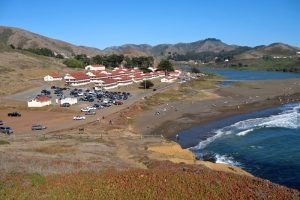Fort Cronkhite, California – Legends of America (original) (raw)
Vintage Fort Cronkhite, California
Golden Gate Bridge from Marin Headlands by Kathy Alexander.
Fort Cronkhite is a former military post located within the Marin Headlands of the Golden Gate Recreational Area, north of San Francisco, California. Standing at the edge of the Pacific Ocean, it was established during WWII and used through the Cold War as part of San Francisco’s first line of defense against enemy attack.
San Francisco Bay has long been recognized as an ideal location for military defense with its sheltered harbor, rich natural resources, and single-mile-wide entrance. The Spanish established the Presidio of San Francisco in 1776 to protect their interests in the bay. During the 1850s and 1860s, the United States Army identified harbor defense as a principal means for protecting the seacoast and the country. After the Gold Rush, the United States Army constructed harbor defense forts at Alcatraz, Fort Point, Angel Island, and Fort Mason.
San Francisco, California Defense
Beginning in the 1890s, the War Department began upgrading the nation’s seacoast forts by constructing new concrete gun batteries and mounting state-of-the-art artillery pieces to use the most modern military technology. This modernization program led to the construction of modern fortifications in the Marin hills overlooking the Golden Gate. Between 1895 and 1905, ten massive Coast Artillery batteries were constructed, and the army designated the lands as Forts Baker and Barry. But by the 1920s, as a result of wartime technological advances, the existing harbor defenses had become obsolete. Recognizing its inadequacies, the army declared that permanent seacoast fortifications should be essential. The army’s primary coast defense weapon, the massive 16-inch rifle, would become the standard harbor defense weapon against enemy ships. Mounted on a high-elevation barbette carriage, these artillery pieces could fire one-ton projectiles more than 25 miles out into the sea.
Fort Baker, California
During the 1930s, diplomatic relations between the United States and Japan eroded. The establishment of Fort Cronkhite, poised at the edge of the Pacific Ocean, directly resulted from the army’s perception of a need to protect the west coast from possible Japanese attack. The Harbor Defenses of San Francisco was assembled and headquartered at Fort Winfield Scott on the Presidio. With its area of responsibility stretching 60 miles from Point Reyes in the north to Half Moon Bay in the south, the Harbor Defenses was charged with protecting the coastline from naval attack, supporting land defenses against beach assault, and ensuring the safety of friendly ships entering and leaving San Francisco Bay. In 1937, the army purchased 800 acres of private land to build Fort Cronkhite. It was the last harbor defense post under the jurisdiction of the Harbor Defenses of San Francisco. Military posts under their command included Fort Winfield Scott, Fort Miley, and Fort Funston in San Francisco, Fort Baker, Fort Barry, and Fort Cronkhite in the Marin Headlands.
World War II-era shipyard in San Francisco, California.
In 1939, as war raged across Europe, President Franklin D. Roosevelt proclaimed a limited national emergency, launching America into a massive pre-war mobilization effort. Almost overnight, factories were constructed to turn raw materials into ships and armaments, and new military posts were established to house and train the rapidly arriving soldiers. Much of this mobilization effort took place in the Bay Area. In addition to the existing military bases, new facilities were constructed that included the Sausalito and Richmond shipyards, the Treasure Island Naval Air Station, and the Oakland Army Base Terminal. Existing military installations were expanded at Mare Island Naval Shipyard, Hamilton Army Air Field, the Benicia Arsenal, and the San Francisco Port of Embarkation. The harbor defense fortifications at the Golden Gate were also expanded, upgraded, and in some cases, re-armed.
Fort Cronkhite was named for the recently deceased Major General Adelbert Cronkhite, a West Point graduate who commanded the 80th Division in France during World War I. In the fall of 1939, two years before our nation officially entered the war, the U.S. Army consisted of only 200,000 enlisted soldiers, and there was little need for new or updated housing. Beginning in 1940, the military started drafting men into the army and navy; military ranks began to swell as hundreds of thousands of draftees, all of whom had to be housed, entered the service. Within five years, the army had risen to the challenge and built temporary military housing for all its soldiers, which amounted to approximately 6 million men by 1944.
Battery Townsley at Fort Cronkhite, California, 1942.
During World War II, providing adequate temporary housing for these new soldiers became a national concern because temporary barracks for servicemen were rarely satisfactory. Military field housing during World War I had been notoriously bad: soldiers often lived in tents, frequently in harsh environments, without proper heating and sanitary facilities. By the late 1930s, Americans demanded a higher quality of life for their soldiers; as a result, the army was expected to provide better housing for the draftees. The Selective Service Act, passed in September 1940, expressly stipulated that no soldiers would be sworn into service until the government made adequate provisions for their shelter.
In 1940, Battery Townsley (1940-1948) at Fort Cronkhite became the first 16-inch gun ever fired in the continental United States, its two massive rifles capable of hurling a 2,100-pound shell 27 miles out to sea. Battery Townsley was complemented by three smaller anti-aircraft guns dotting Wolf Ridge. During wartime, soldiers manning coastal batteries needed to be battle-ready with 15 minutes’ notice. As a result, those working the guns at Fort Cronkhite practically lived within Battery Townsley’s cement walls, rarely straying beyond the fort’s barracks and mess hall.
Fort Cronkhite, California Soldiers
In the meantime, the army needed immediate plans to accommodate all incoming military men. The two construction divisions, the Quartermaster Department and the Corps of Engineers were immediately provided housing quickly and cheaply. They established five principles to guide mobilization construction plans: speed, simplicity, conservation of materials, flexibility, and safety. Using these principles. The construction divisions were directed to draw up standard building plans for simple wood-frame structures. The buildings were made with inexpensive and prefabricated materials and could be constructed in an assembly-line fashion. The standard plans were bundled into construction packages that could meet the needs of a 125-man company, complete with barracks, mess halls, and recreation and supply buildings. Eventually, 43 buildings were constructed. These structures, which now included central heating, interior showers and restrooms, and other modern conveniences, were recognized as superior to World War I tents.
Fort Cronkhite, California Buildings today by Kathy Alexander.
Construction took place at break-neck speed due to readily available labor resources and ingenuity with building materials. Construction crews at Fort Ord in Monterey, California, boasted that they could finish a building every 54 minutes. By June 1941, the army had built housing for 1.2 million men. By June 1942, they could accommodate 2.4 million men; by January 1943, 4.6 million men were housed within these wood-frame buildings.
In 1943, the invention of radar to detect approaching ships and planes increased the effectiveness of the 16-inch guns and the nearby antiaircraft guns. In January 1944, as the threat of a Japanese attack subsided, Fort Cronkhite, like so many other coastal artillery posts, was soon to be stripped of its guns, which had been made obsolete by long-range bombers, missiles, and the atomic bomb. At that time, men on active duty were transferred overseas, and the army established the Commando Combat School at Fort Cronkhite. The school, the first in the Western Defense Command, trained officers from the U.S. Army, Coast Guard, and California State Guard in commando tactics, combat training, and leadership skills.
Nike Missile Battery at Fort Cronkhite, California, 1959, courtesy National Park Service.
During the 1950s, Korean War soldiers were stationed here, and in 1955, Nike missile battery 87 was constructed, one of the 300 across the nation. The site continued to serve which served until 1965. By this point, the army had removed most of the eastern half of the Fort Cronkhite wood-frame buildings and replaced them with new cinderblock barracks constructed for the Nike site personnel. By 1974 the army began to deactivate the former post. Fort Cronkhite was officially discontinued as a U.S. Army installation in September 1974 and transferred to the National Park Service the following year.
Fort Cronkhite now has a new life as part of the Golden Gate National Recreation Area, a unit of the National Park Service. Its military history is being interpreted for future generations. Visitors will see that most of the “temporary” wood-frame buildings built by the army nearly 70 years ago are still being used today. In addition to providing office space for the National Park Service, this former World War II cantonment is now home to many nonprofit, educational and environmental park partners. The 1940 Barracks #1059 has been restored to its original appearance, with period furnishings that reflect its use during World War II, the Korean War, and the 1960s.
More Information:
Fort Cronkhite and Rodeo Beach, Marin County, California, courtesy Wikipedia.
Golden Gate National Recreation Area
Building 201, Fort Mason
San Francisco, CA 94123-0022
415-561-4700
© Kathy Alexander/Legends of America, updated January 2023.
Also See:
War & Military in American History
Sources:
Military Museum
National Park Service
WWII in San Francisco – NPS
